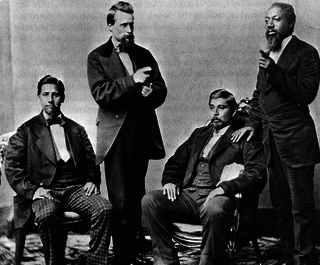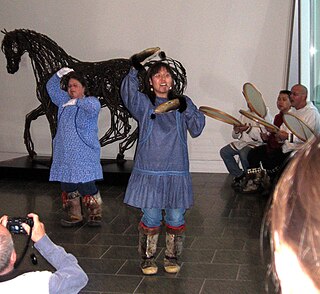
The Lakota are a Native American people. Also known as the Teton Sioux, they are one of the three prominent subcultures of the Sioux people. Their current lands are in North and South Dakota. They speak Lakȟótiyapi—the Lakota language, the westernmost of three closely related languages that belong to the Siouan language family.

Indigenous music of North America, which includes American Indian music or Native American music, is the music that is used, created or performed by Indigenous peoples of North America, including Native Americans in the United States and Aboriginal peoples in Canada, Indigenous peoples of Mexico, and other North American countries—especially traditional tribal music, such as Pueblo music and Inuit music. In addition to the traditional music of the Native American groups, there now exist pan-Indianism and intertribal genres as well as distinct Native American subgenres of popular music including: rock, blues, hip hop, classical, film music, and reggae, as well as unique popular styles like chicken scratch and New Mexico music.

Blood quantum laws or Indian blood laws are laws in the United States that define Native American status by fractions of Native American ancestry. These laws were enacted by the federal government and state governments as a way to establish legally defined racial population groups. By contrast, many tribes do not include blood quantum as part of their own enrollment criteria.

The Eiteljorg Museum of American Indians and Western Art is an art museum in downtown Indianapolis, Indiana, United States. The Eiteljorg houses an extensive collection of visual arts by indigenous peoples of the Americas as well as Western American paintings and sculptures collected by businessman and philanthropist Harrison Eiteljorg (1903–1997). The museum houses one of the finest collections of Native contemporary art in the world.

Nole Floyd "Nokie" Edwards was an American musician and member of the Rock and Roll Hall of Fame. He was primarily a guitarist, best known for his work with The Ventures, and was known in Japan as the 'King of Guitars'. Edwards was also an actor, who appeared briefly on Deadwood, an American Western drama television series.

The Institute of American Indian Arts (IAIA) is a public tribal land-grant college in Santa Fe, New Mexico. The college focuses on Native American art. It operates the Museum of Contemporary Native Arts (MoCNA), which is housed in the historic Santa Fe Federal Building, a landmark Pueblo Revival building listed on the National Register of Historic Places as Federal Building. The museum houses the National Collection of Contemporary Indian Art, with more than 7,000 items.

Rickey Medlocke is an American musician, best known as the frontman/guitarist for the Southern rock band Blackfoot and a member of Lynyrd Skynyrd. During his first stint with Lynyrd Skynyrd from 1971 to 1972, he played drums and sang lead on a few songs that would initially be released on 1978's "First and Last". Medlocke would rejoin Blackfoot in 1972 and later returned to Lynyrd Skynyrd in 1996 as a guitarist with whom he continues to tour and record today.

Native American identity in the United States is an evolving topic based on the struggle to define "Native American" or "(American) Indian" both for people who consider themselves Native American and for people who do not. Some people seek an identity that will provide for a stable definition for legal, social, and personal purposes. There are a number of different factors which have been used to define "Indianness," and the source and potential use of the definition play a role in what definition is used. Facets which characterize "Indianness" include culture, society, genes/biology, law, and self-identity. An important question is whether the definition should be dynamic and changeable across time and situation, or whether it is possible to define "Indianness" in a static way. The dynamic definitions may be based in how Indians adapt and adjust to dominant society, which may be called an "oppositional process" by which the boundaries between Indians and the dominant groups are maintained. Another reason for dynamic definitions is the process of "ethnogenesis", which is the process by which the ethnic identity of the group is developed and renewed as social organizations and cultures evolve. The question of identity, especially aboriginal identity, is common in many societies worldwide.
Verdell Primeaux is an Oglala, Yankton/Ponca singer and songwriter in the Native American Church tradition of peyote songs, accompanied by rattle and water drum. He and Johnny Mike (Navajo) are known as the duo Primeaux and Mike.
The Native Writers' Circle of the Americas (NWCA) is an organization of writers who identify as being Native American, First Nations, or of Native American ancestry.

The impact of the COVID-19 pandemic on Native American tribes and tribal communities has been severe and has emphasized underlying inequalities in Native American communities compared to the majority of the American population. The pandemic exacerbated existing healthcare and other economic and social disparities between Native Americans and other racial and ethnic groups in the United States. Along with black Americans, Latinos, and Pacific Islanders, the death rate in Native Americans due to COVID-19 was twice that of white and Asian Americans, with Native Americans having the highest mortality rate of all racial and ethnic groups nationwide. As of January 5, 2021, the mortality impact in Native American populations from COVID-19 was 1 in 595 or 168.4 deaths in 100,000, compared to 1 in 1,030 for white Americans and 1 in 1,670 for Asian Americans. Prior to the pandemic, Native Americans were already at a higher risk for infectious disease and mortality than any other group in the United States.
Native American newspapers are news publications in the United States published by Native American people often for Native American audiences. The first such publication was the Cherokee Phoenix, started in 1828 by the Cherokee Nation. Although Native American people have always written for state and local newspapers, including the official publications of Native American boarding schools, periodicals produced by Native people themselves were relatively few and far between until the 20th century.










